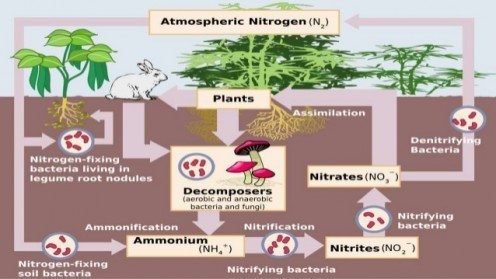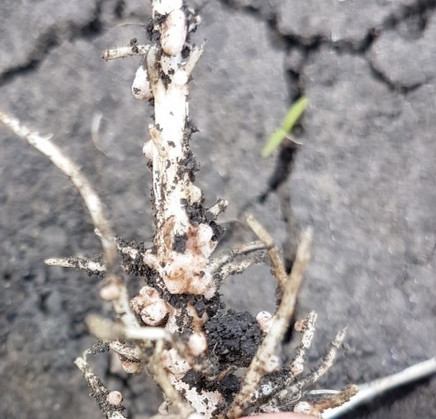Farmers Quest for Nodules
- speed7

- Jan 1, 2022
- 3 min read

To begin with, for many years farmers have tried to establish healthy nodules on their pulse crops and legumes, some successfully and others not always successful. So the pursuit of healthy nitrogen fixating nodules continues on the farms today.
It’s interesting to know that this is the most natural of ways to increase our yields, maintain healthy soils, decrease our dependence on synthetic nitrogen products, and produce a healthier product for consumers.
What is a Root Nodule

First of all, an indeterminate root nodule is a swelling on the roots of a leguminous plant such as soybeans, fava beans, field peas, and many other types of legumes. This root nodule contains bacteria of the genus Rhizobium, which is capable of nitrogen fixation.
Moreover, Rhizobia bacteria enters from the soil through the root hairs to form the root nodule. The rhizobia in the root nodule will go through a multiplication period. Once the nodule is fully formed it is connected to the xylem and phloem of the plant’s distribution system. Last, the connection between the nodule and plant distribution channels created by the plant will start to fixate nitrogen.
Soil Health Assessment
In order to start understanding if you have soils that promote beneficial bacteria growth we first need to identify our soil conditions.

For example, there are some indicators of proper soil health for beneficial bacterial growth. Moreover, indicators can be assessed by qualitative or quantitative techniques.
Soil Analysis
Existing Vegetation
Presence of Earthworms (Biological)
Soil Organic Matter
Presence of Compaction
Type of Soil
Climate
Water Holding Capacity
Rhizobia’s Habitat
In the quest for root nodules to form we first must maintain our lands making certain the Rhizobia bacteria is available in the soil, we are planting the legumes in. Rhizobia is a naturally occurring bacteria in healthy soils. Should the Rhizobia not be present in the soil, action must be taken to fix the absence of this bacteria. Rhizobia bacteria is a living organism. Healthily balanced soils encourage healthy bacterial growth for vegetation.
Promoting Beneficial Bacteria Growth
Steps to creating a healthy environment for beneficial bacteria growth include the following:
Soil Ph
Soil Organic Matter
Compaction
Natural Soil Drainage
Cultivation Techniques
No water-logging
Rhizobia and Mycorrhizal Fungi
Since we previously learned that Rhizobia are beneficial soil bacteria known for fixing nitrogen inside legume root nodules, the function of Mycorrhizal fungi is ubiquitous root symbionts that provide plants with nutrients and other benefits.

It’s important to know that understanding the roles of the Rhizobia and Mycorrhizal Fungi will help you determine what products to purchase when adding beneficial bacteria to the soils.
One of the most familiar strains of bacteria, beneficial for fixating the nitrogen, is known as Bradyrhizobium Japonicum.
Even more, Bradyrhizobium Japonicum legume roots a species of legume root nodulating, micro symbiotic nitrogen-fixing bacteria. The species is one of many Gram-negative, rod-shaped bacteria commonly referred to as rhizobia.
Evaluating Healthy Root Nodules
First of all, nodules form at different stages of the plant life cycle depending on the legume or pulse you are planting. However, most nodules form early in the development stage of the plant. Plant breeders can relay the appropriate nodule formation period.
Soybeans develop nodules at V2 to V4 stage. Under these circumstances, factors like weather and germination period will affect this time.
Characteristics of a healthy nodule:
Firstly, pink to red on the inside
Secondly, 2 – 4 mm in diameter
Then, 20 – 50 nodules per plant
Finally, Vibrant green plant appearance
The pink or red color caused by leghemoglobin (similar to hemoglobin in blood) that controls oxygen flow to the bacteria.
Evaluating Defective Root Nodules
Plants can put on nodules, but the nodules may not be sufficient for fixating nitrogen. Poor nodules happen when inefficient Rhizobium strain, poor plant nutrition, pod filling, or other plant stress have occurred.
Characteristics of poor nodules:
Firstly, low number of nodules
Secondly, brown or gray in color
Finally, yellow or pale green crop color
As a consequence, inadequate nitrogen fixating nodules will result in lower yields, disease, and fungus-prone plants, and will not utilize fertilizer efficiently. It is common for many farmers to apply nitrogen when they notice the nodules have characteristics of poorly developed nodules. Haphazardly adding nitrogen is not an effective long-term method of fixing the problem of poorly developed nodules. Moreover, the addition of nitrogen commonly goes underutilized only to contaminate the nearby waters.
Conclusion
Managing farm soils by only managing fertilizers, pesticides and herbicides is not the cure-all answer for record-breaking yields. Environmental impacts from this behavior towards managing farms degrade our soil health, contaminate our drinking water supplies, destroy beneficial species and wildlife, and cause added food safety concerns.
As we previously stated, having a well-established foundation (our soils) is the beginning of a successful agronomy program. Starting with the beneficial soil bacterias will result in a positive impact on crop yield, plant health, and a reduced cost of inputs.
Today’s farmers are more proactive caretakers of their soils, low dependence on chemicals, and high awareness of the benefits the soil does for the farms. Conservative actions are performed routinely by modern-day farmers.
















Comments